Home Decor
Indonesian Style Home Decor: Infuse Your Space With Cultural Charm!
Get ready to transform your home with Indonesian style decor that combines vibrant colors and natural materials—discover the secrets behind this cultural charm!
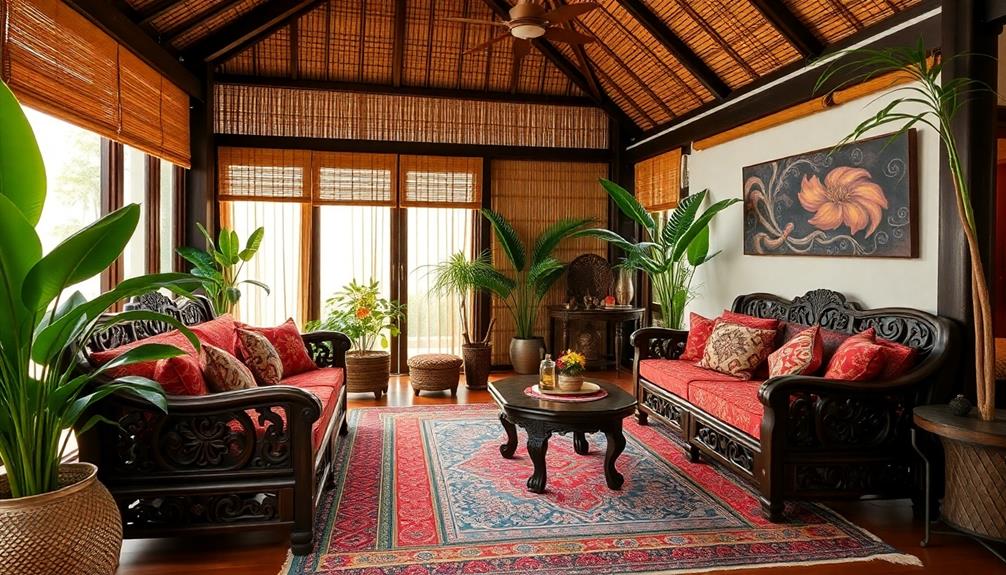
Indonesian style home decor brings vibrant cultural charm to your space, blending natural materials and intricate craftsmanship. You can embrace earthy tones, like sandy beige and green, which create warm, inviting environments. Incorporate wooden furniture with traditional carvings and soft textiles in striking colors like deep red or turquoise for added flair. Open-air designs promote a connection with nature, while indoor plants and water features enhance tranquility. By mixing these elements, you'll craft a serene yet lively atmosphere. Explore how these styles can transform your home into a slice of paradise right here. Immerse yourself in the rich tradition and artistry of Indonesian decor ideas, from batik prints to handwoven rattan accents. Consider incorporating statement pieces like a hand-carved canopy bed or a bold, geometric-patterned rug to elevate the space. Embrace the beauty of Indonesian culture within your home and infuse each room with its unique, exotic charm.
Key Takeaways
- Incorporate natural materials like wood, bamboo, and stone to create a warm, inviting atmosphere that reflects Indonesian craftsmanship.
- Use vibrant textiles such as batik and ikat to add color and cultural significance to your decor.
- Embrace open spaces and airy designs that blur indoor-outdoor boundaries, promoting natural ventilation and tranquility.
- Integrate indoor plants and water features to enhance ambiance and evoke the serene beauty of Indonesian landscapes.
- Choose an earthy color palette with accents of deep red, gold, and turquoise to bring cultural charm and warmth into your space.
History of Balinese Home Decor
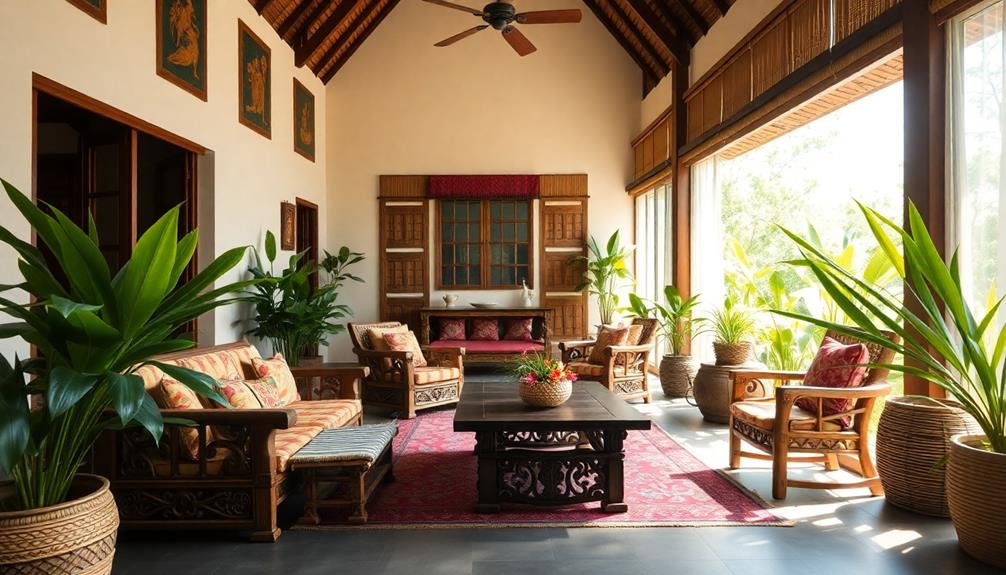
When you explore Balinese home decor, you're diving into a rich tapestry woven from the island's Hindu-Buddhist heritage and indigenous influences. This decor reflects the spiritual beliefs and cultural richness that define traditional Balinese homes, known as Bale.
These homes are designed to create harmony with nature, utilizing natural materials like wood and stone to craft serene living spaces that resonate with tranquility. The use of vibrant colors and intricate patterns in decor items like Indonesian decorative pillows further enhances these spaces, creating a warm and inviting atmosphere.
The evolution of Balinese home decor took a notable turn during the 19th century, when Dutch colonization introduced European architectural styles. This fusion resulted in a unique blend that still influences Balinese decor today.
As Bali gained international recognition as a tourist destination in the 20th century, the world began to appreciate the aesthetic appeal and cultural significance of Balinese home decor.
Intricate carvings and designs become central elements, showcasing the craftsmanship that embodies the island's rich cultural heritage. Balinese decor encourages you to transform your modern living spaces into serene havens, honoring the connection to nature and spirituality that's deeply ingrained in Indonesian style.
Embrace this cultural charm and create a space that reflects both beauty and meaning.
Key Elements of Balinese Design
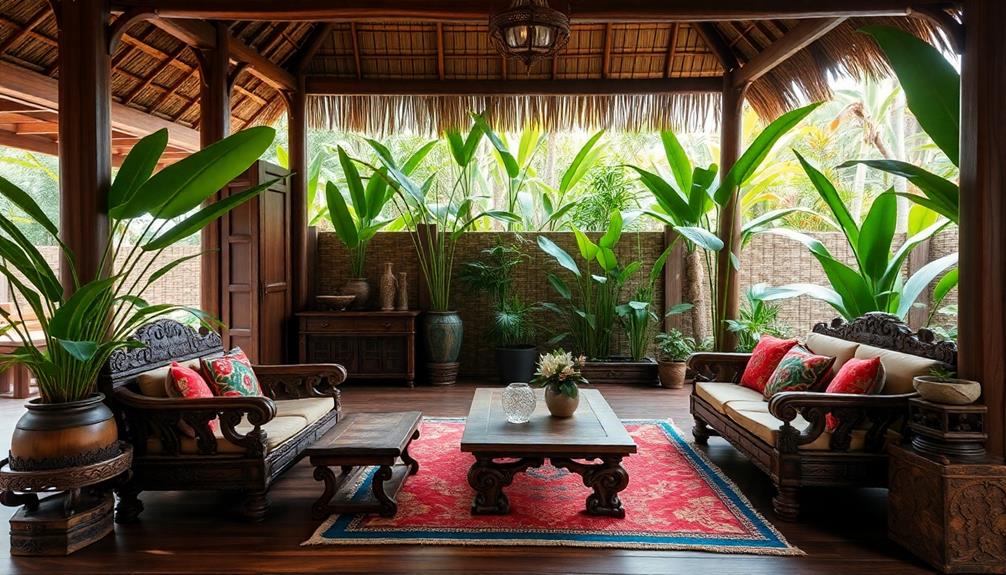
To truly capture the essence of Balinese design, you need to embrace its key elements, which harmoniously blend natural materials and traditional craftsmanship. Central to this style are natural elements like wood, bamboo, and stone, fostering a connection to the environment. Wooden furniture, often made from durable teak and mahogany, showcases intricate carvings that reflect deep spiritual beliefs.
Balinese decor thrives on vibrant colors and intricate patterns, thanks to traditional textiles such as batik and ikat. These textiles enhance the aesthetic appeal, infusing your space with life. The use of earthy tones, like shades of brown, beige, and green, produces a serene oasis, while vibrant accents, such as deep reds and turquoises, add a lively touch.
Open spaces are a hallmark of Balinese design, blurring the lines between indoor and outdoor environments. This approach promotes natural ventilation and tranquility, allowing you to experience a peaceful atmosphere.
| Element | Description |
|---|---|
| Natural Materials | Wood, bamboo, and stone create warmth |
| Wooden Furniture | Intricate carvings from teak and mahogany |
| Open Spaces | Seamless indoor and outdoor living |
Modern Incorporation of Balinese Style
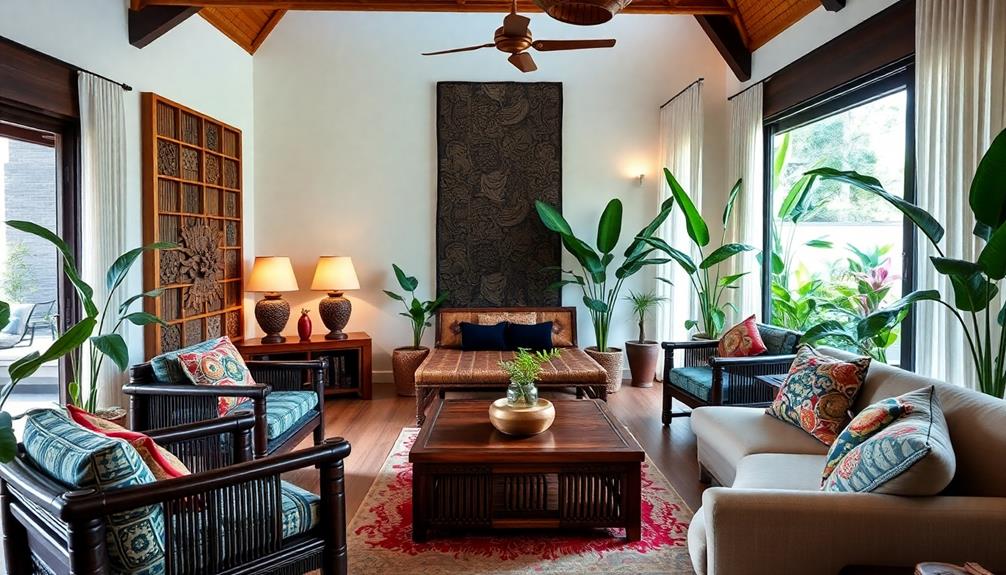
Embracing the modern incorporation of Balinese style can transform your living space into a serene retreat that honors tradition while reflecting contemporary aesthetics.
This interior design trend seamlessly blends traditional Balinese elements, like hand-carved furniture and vibrant colors, with modern decor. By utilizing natural elements, such as teak and bamboo, you not only celebrate Balinese craftsmanship but also promote sustainability in your home.
Incorporating natural materials like wood and stone will further enhance the connection to nature and create a calming atmosphere.
To create a tranquil atmosphere, consider integrating indoor plants and water features inspired by Balinese aesthetics. These elements foster a connection with nature and enhance the overall ambiance, making your space feel more inviting.
The open-air design characteristic of Balinese homes blurs the lines between indoor and outdoor spaces, allowing for greater natural ventilation and an airy feel.
Digital tools like HomeDesigns AI can help you visualize how these traditional elements fit into your modern space, empowering you to achieve the look you desire.
By thoughtfully incorporating these features, you can cultivate serene environments that reflect your personal style while paying homage to rich Balinese culture.
It's time to transform your home into a beautiful sanctuary that embodies both tradition and modernity.
Nature-Inspired Features and Impact
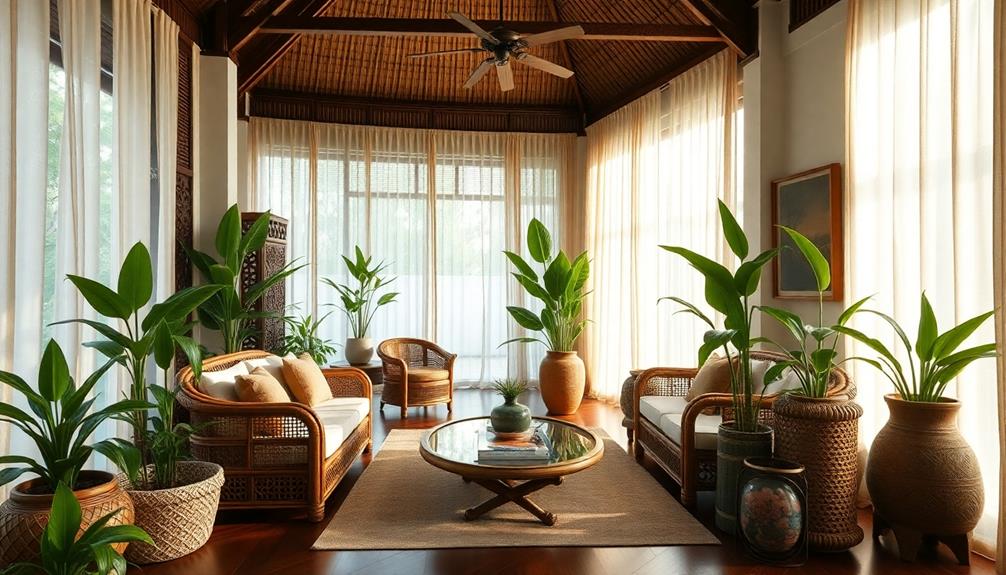
Incorporating nature-inspired features into your home decor can profoundly impact the ambiance and overall feel of your space. By integrating natural elements, you'll create a serene environment that resonates with the cultural charm of Indonesia. Additionally, incorporating unique art pieces such as Indonesian decor masks can further enhance the cultural aesthetic of your home, blending artistic expression with natural beauty.
- Tropical plants like palms, orchids, and ferns enhance air quality while invoking the tranquility of Balinese gardens.
- Water features, such as ponds or fountains, introduce soothing sounds that promote relaxation and greatly elevate your space's atmosphere.
- Stone sculptures and wooden accents not only evoke a tropical vibe but also add visual interest and depth to your interiors.
Strategically placed indoor plants soften architectural lines, fostering an organic feel that blurs the boundaries between indoor and outdoor areas.
The balance of natural woods and stones with lush greenery cultivates a grounded and harmonious connection. This blend of elements invites nature into your home, allowing you to enjoy a peaceful retreat amidst the hustle of daily life.
Embracing these nature-inspired features will transform your space into a tranquil haven, inviting you to unwind while celebrating the beauty of the natural world.
Color Palette and Atmosphere
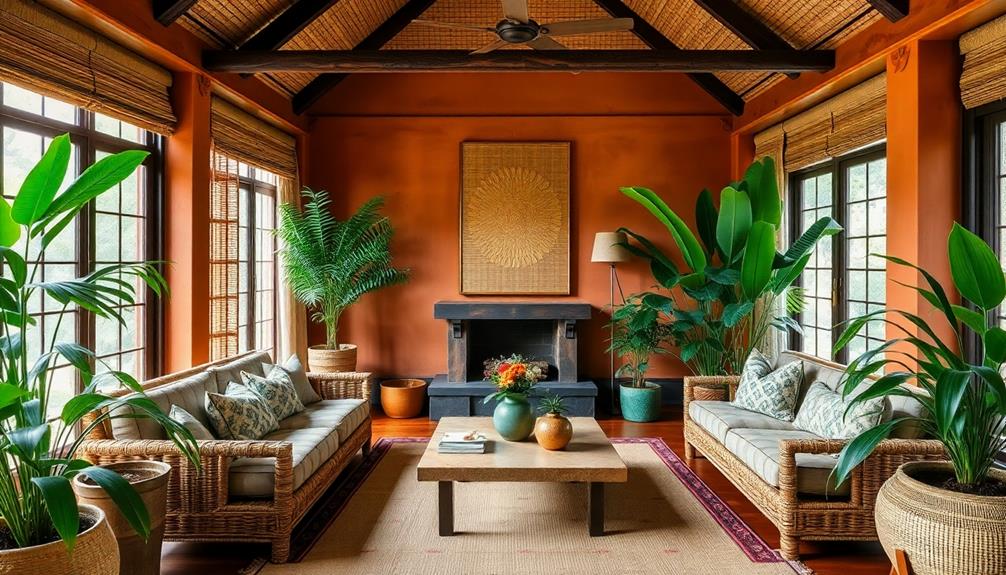
When you select a color palette for your Indonesian-style home decor, you're not just choosing hues; you're creating an atmosphere that reflects the natural beauty and rich culture of Indonesia. Earthy tones like sandy beige, brown, and green dominate your space, crafting a warm and inviting environment that promotes relaxation and tranquility.
These colors echo the landscapes of Indonesia, bringing a touch of nature indoors. Incorporating elements such as traditional artistry through decor masks can further enhance this ambiance, providing a visual storytelling element that enriches your space.
To enhance this calming aura, you can integrate vibrant accents such as deep red, gold, and turquoise through textiles and decorative elements. These colors not only add visual appeal but also carry cultural significance, showcasing Indonesia's rich heritage.
Soft textiles in ocean hues can evoke a serene ambiance reminiscent of coastal environments, further enriching your home's atmosphere.
Utilizing natural light enhances the overall effect, allowing the earthy tones and vibrant accents to shine. Consider incorporating patterns like floral designs and geometric motifs to add depth and interest, connecting your decor to the cultural narratives of Indonesia.
With the right color palette, you're not just decorating; you're infusing your space with a vibrant story that resonates with beauty and tradition.
Frequently Asked Questions
What Are the Best Ways to Source Authentic Indonesian Decor?
To source authentic Indonesian decor, explore local markets, connect with artisans, and check online platforms specializing in Indonesian crafts. You'll find unique items that reflect the culture, enhancing your space with genuine charm.
How Do I Maintain and Care for Indonesian Textiles?
To keep your vibrant batik cloth looking fresh, wash it gently in cold water with mild detergent. Avoid direct sunlight when drying, and store it folded in a cool, dry place to prevent fading.
Can Indonesian Decor Fit in a Minimalist Design Scheme?
Yes, Indonesian decor can fit in a minimalist design scheme. You'll want to choose pieces with clean lines and subtle colors, allowing the cultural charm to enhance the simplicity without overwhelming your space.
What Budget Should I Plan for Indonesian Home Decor Items?
When planning your budget for home decor, consider both quality and authenticity. You'll want to allocate funds for unique pieces, local artisans, and shipping costs while ensuring you balance aesthetics and functionality for your space.
Are There Eco-Friendly Options for Indonesian-Style Furnishings?
Absolutely, you can find eco-friendly options for Indonesian-style furnishings. Look for sustainably sourced wood, bamboo, and recycled materials. These choices not only enhance your decor but also support environmental sustainability and ethical craftsmanship.
Conclusion
Incorporating Indonesian style into your home decor can truly transform your space into a serene sanctuary. Imagine stepping into a living room adorned with intricate Balinese carvings, lush greenery, and vibrant textiles. This blend of natural elements and rich colors creates a calming atmosphere, perfect for relaxation. By adding a handcrafted wooden coffee table and colorful batik cushions, you'll not only celebrate the beauty of Balinese design but also infuse your home with cultural charm that tells a story.
Home Decor
How Feng Shui Can Help You Achieve the Perfect Home Energy Flow
Optimize your living space with Feng Shui principles to invite positive energy; discover how simple changes can transform your home into a sanctuary.
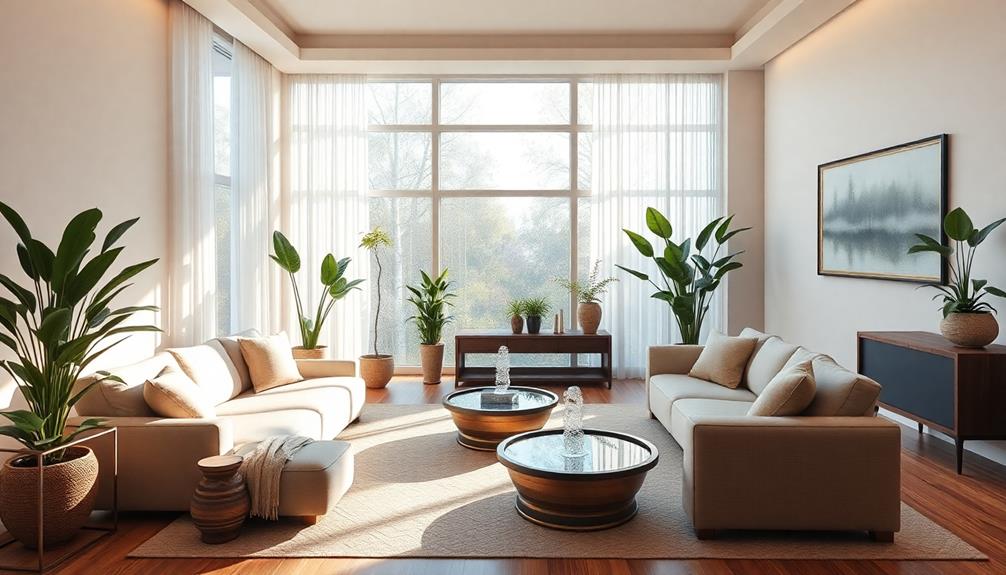
Feng Shui can help you achieve the perfect home energy flow by creating a harmonious space that invites positive chi. Start with mindful furniture placement; for instance, positioning your bed to see the door promotes security and comfort. Utilize the Bagua map to identify areas in your home that can enhance aspects like love or wealth. Declutter to clear any energetic blocks, and incorporate natural elements for tranquility. By balancing colors linked to the five elements, you'll enhance the overall atmosphere. Explore how to apply these principles effectively to transform your living space even further.
Key Takeaways
- Feng Shui enhances home energy flow by promoting harmonious chi movement through strategic furniture placement and decluttering.
- The Bagua map identifies areas of life to improve, aligning spaces with specific energies for wealth, love, and health.
- Incorporating the five elements and corresponding colors fosters balanced energy dynamics in each room.
- Regular assessments and adjustments maintain positive energy flow, adapting to seasonal changes and personal needs.
- Creating open pathways and using natural elements, like plants, enhances well-being and promotes a nurturing environment.
Overview of Feng Shui Principles
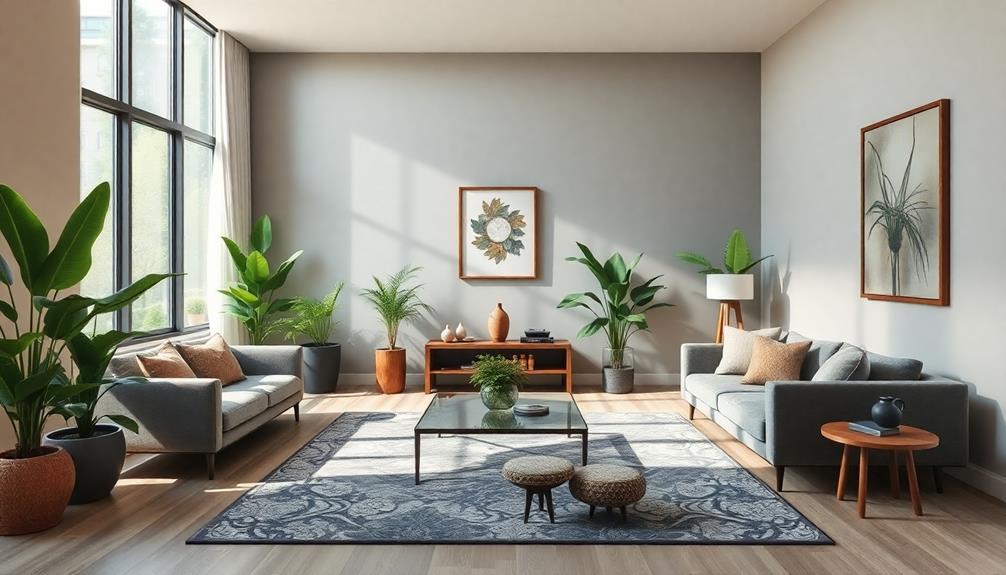
Feng Shui is all about creating a harmonious living space by enhancing the flow of chi energy. To achieve this, you'll want to understand some key Feng Shui principles that can transform your environment.
The five elements of Feng Shui—wood, fire, earth, metal, and water—each play a significant role in influencing energy flow. Incorporating elements like Indonesian decorative pillows can add vibrant colors and textures that enhance the overall ambiance. By incorporating these elements thoughtfully, you can establish balance and promote positive energy.
Another fundamental concept is Yin and Yang, representing the balance between passive and active energies. Striking this balance is essential for creating an inviting atmosphere. For example, a room with too much yang energy might feel chaotic, while an excess of yin could make it overly passive.
Arrangement of furniture is also important; it fosters movement and interaction, which enhances energy flow. Make sure your furniture doesn't block pathways but rather encourages free movement.
While the Bagua map is an important tool for identifying specific areas to enhance, the overarching principles of Feng Shui guide you in creating a space where chi can flow freely.
Understanding the Bagua Map
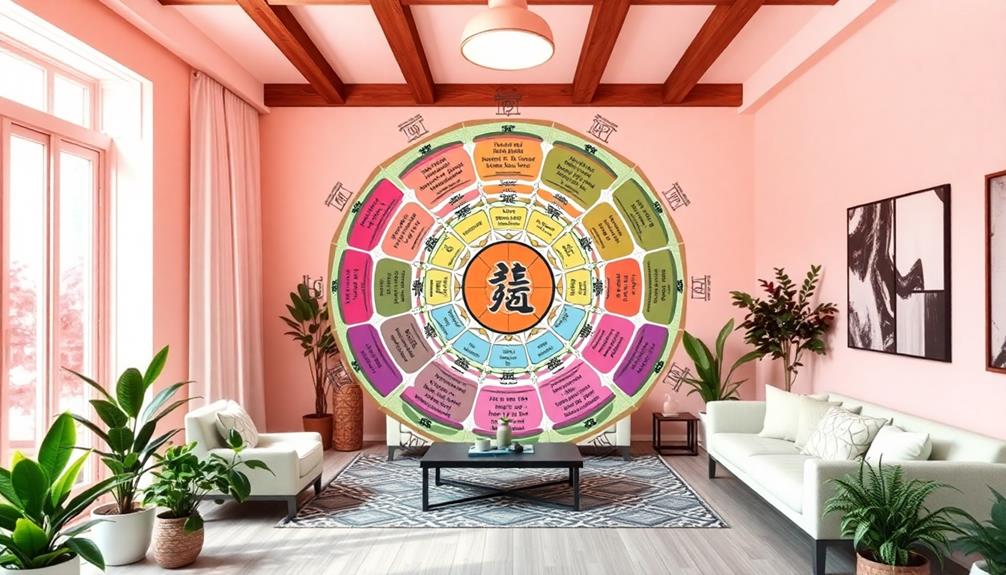
One powerful tool for enhancing your home's energy flow is the Bagua Map. This 8-sided diagram, often used by Feng Shui experts, helps you analyze and improve the energy in your space. You can also consider incorporating elements inspired by your culture, such as vibrant colors and traditional motifs, to create a unique ambiance in your home.
Here's how it works:
- Each area of the Bagua Map corresponds to specific life aspects like wealth, love, and family.
- The map aligns with your front door, the primary entry point for chi energy.
- Colors and elements linked to each area can enhance your space's energy.
To effectively use the Bagua Map, start by placing it over your home plan, ensuring the bottom edge aligns with your front door. Each section will reveal where you can make adjustments to improve various life aspects.
For instance, if you're looking to boost your wealth, focus on the area dedicated to prosperity and incorporate colors and decor that resonate with that energy. You might draw inspiration from Indonesian wedding decor ideas to bring a vibrant and cultural touch to your design.
You can apply the Bagua Map to individual rooms or your entire home, making it a versatile tool for enhancing your living environment.
Benefits of Feng Shui at Home

Harnessing the principles of Feng Shui can greatly enhance your home environment, leading to a multitude of benefits. By promoting a balanced energy flow, you can experience improved emotional well-being, increased feelings of safety, and comfort within your harmonious living space.
One of the core aspects of Feng Shui is decluttering, which opens up space for positive energy while reducing stressors that negatively impact your mood. Additionally, using the Bagua map allows you to focus on enhancing specific areas of your life, such as love or finances, through thoughtful placement of decor and furniture.
Here's a quick overview of the benefits you can enjoy:
| Benefit | Description |
|---|---|
| Emotional Well-being | Enhanced feelings of safety and comfort in your home. |
| Improved Relationships | Inviting spaces that foster better communication. |
| Increased Life Satisfaction | Decluttering leads to reduced stress and enhanced mood. |
| Personal Growth | Regular adjustments support ongoing positive energy flow. |
Embracing these Feng Shui principles can transform your home into a nurturing sanctuary, ultimately supporting your personal growth and well-being.
Practical Applications in Different Rooms
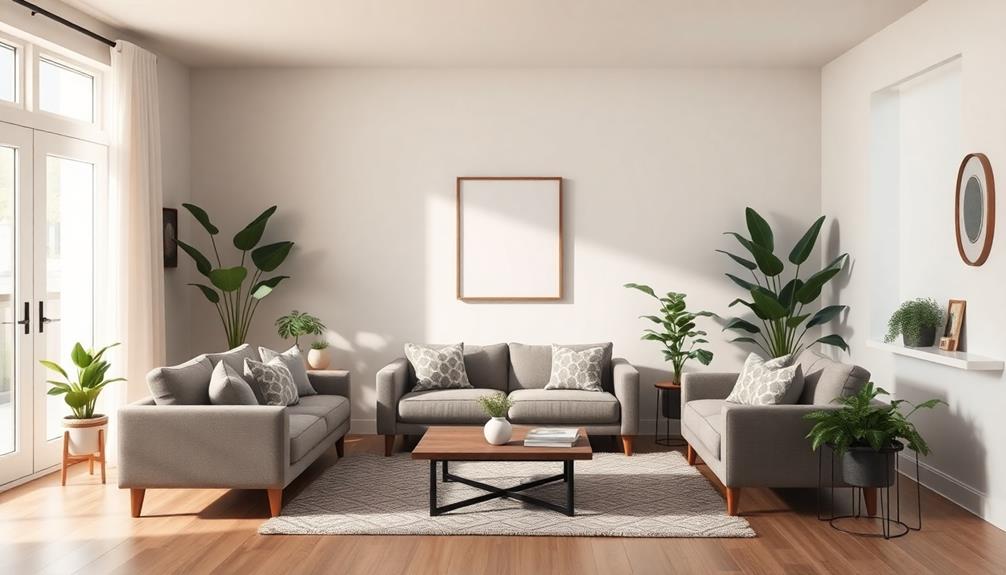
Often, small adjustments in each room can greatly enhance the energy flow in your home. By focusing on furniture placement and creating a commanding position in key areas, you can foster a more harmonious atmosphere.
Incorporating natural materials like wood and stone, reminiscent of Balinese design characteristics, can also contribute to a calming environment.
- Bedroom: Position your bed so you can see the door without being directly aligned with it, promoting security and restful energy.
- Living Room: Arrange furniture to face the entryway, allowing for easy movement and encouraging social interaction.
- Kitchen: Keep it decluttered by removing expired items and unnecessary appliances to nurture abundance and well-being.
In your home office, place your desk in a commanding position that gives you a clear view of the entrance. This setup enhances focus and productivity while making you feel in control.
For bathrooms, use calming colors and strategically place mirrors to redirect negative energy, creating a balanced atmosphere.
Techniques for Enhancing Energy Flow
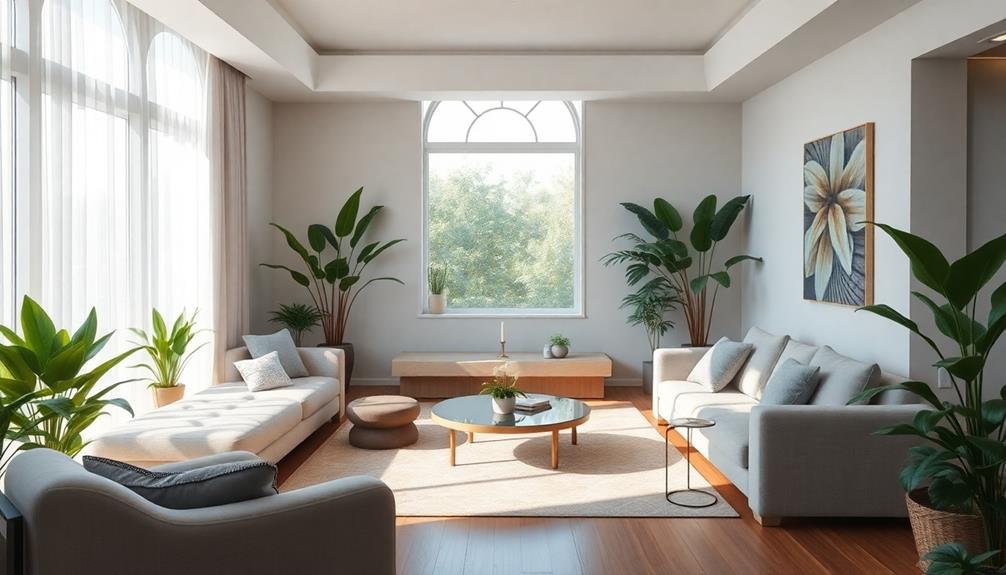
To enhance energy flow in your home, start by decluttering to clear out any blocks that hinder positive vibes.
Incorporating elements of traditional artistry such as Indonesian decor masks can add vibrant colors and unique designs that promote a sense of cultural harmony.
Next, consider your furniture placement; positioning items in the commanding position can foster a feeling of control and security.
Decluttering for Positive Energy
Decluttering transforms your space by removing energy blocks that hinder the flow of chi, the essential life force in Feng Shui. A clutter-free environment not only enhances the aesthetic of your home but also fosters positive energy.
Incorporating unique decorative elements, such as Indonesian decor masks, can further enrich your space by adding cultural significance and storytelling. Here are some effective techniques to help you declutter:
- Regularly assess your belongings and eliminate expired or unused items.
- Implement the "one in, one out" rule to maintain a consistent flow of positive energy.
- Organize with intention using functional and visually pleasing storage solutions.
By clearing visual clutter, especially in high-traffic areas like your kitchen and living room, you enhance mental clarity and emotional stability. This contributes to an overall sense of calm and well-being.
Remember, decluttering isn't just about tidying up; it's about creating space for new opportunities and positive experiences.
When you actively engage in decluttering, you're not just cleaning your home; you're inviting a revitalized chi flow that nurtures your spirit.
Embrace the process, and watch how your living environment transforms into a sanctuary of positive energy.
Strategic Furniture Placement
Creating a harmonious energy flow in your home goes beyond decluttering; it involves strategic furniture placement. Start by positioning larger furniture pieces, like your sofa and bed, in a commanding position where you can see the entrance. This arrangement promotes a sense of security and control in your space.
To enhance this concept, consider incorporating elements from luxury tropical designs that emphasize natural aesthetics and calming environments.
Next, be mindful of pathways. Avoid blocking walkways with furniture, as this can create stagnant energy. Open pathways encourage smooth energy flow and enhance the overall atmosphere of the room.
Incorporating natural elements, such as plants or wooden furniture, can ground your space and invite positive energy and tranquility.
Choose soft, soothing colors for your furniture to foster a calming environment that supports relaxation and emotional well-being.
Lastly, remember to regularly reassess your furniture placement. Seasonal changes or shifts in your personal needs may require adjustments to guarantee the energy flow remains vibrant and responsive.
Elemental Color Integration
Integrating elemental colors into your home can considerably enhance the energy flow, making spaces feel more vibrant and alive.
By understanding how colors correspond to the five elements in Feng Shui, you can create a harmonious atmosphere that resonates with your intentions.
Additionally, incorporating an open layout inspired by tropical villa plans can further promote a sense of spaciousness and tranquility.
Here are some techniques for effective elemental color integration:
- Choose colors based on the Bagua map: Use pinks in the love corner to boost romantic energy or greens in the family area for growth and harmony.
- Select colors for specific room atmospheres: Opt for calming blues in bedrooms to promote tranquility or bright yellows in kitchens for warmth.
- Incorporate colored decor strategically: Add metal tones in the west sector to support creativity and children's energy.
Addressing Limitations of Feng Shui

While Feng Shui can offer some benefits, its effectiveness really depends on your personal beliefs and perceptions.
Incorporating elements from traditional Indonesian housing may enhance the energy flow in your home, as these structures often reflect spiritual elements and cultural symbolism.
It's important to remember that it shouldn't be your only strategy for well-being; combining it with other approaches can lead to more thorough solutions.
Also, keep in mind that consulting a practitioner can be costly, which might limit access for some individuals.
Perception Variability
Although many people report positive changes from feng shui practices, the effectiveness of these methods can vary widely from person to person. This perception variability stems from several factors, primarily rooted in individual experiences and personal beliefs. For instance, the incorporation of natural materials in home decor, like those found in traditional Indonesian style home decor, can greatly influence how one perceives the energy flow within their space.
- The subjective nature of feng shui means benefits can differ considerably.
- Anecdotal evidence supports emotional well-being improvements, but scientific validation is limited.
- Interpretations of feng shui principles can lead to diverse applications and outcomes.
While feng shui serves as a useful tool for enhancing energy flow in your home, it shouldn't be viewed as a one-size-fits-all solution. What works for you may not resonate with someone else.
You might find that certain adjustments bring harmony and balance, while others see no change at all. This highlights the importance of personal exploration and adaptation in your feng shui journey.
Ultimately, your unique perception and belief system will shape how you experience feng shui's impact. Embrace the process, experiment with different techniques, and remember that the journey to achieving energy flow in your home is just as considerable as the results you hope to attain.
Need for Broader Strategies
Many homeowners find that relying solely on feng shui can fall short when it comes to addressing life's complexities. While feng shui consultants can help you enhance energy flow in your living space, they can't tackle deeper emotional or psychological issues that might require professional intervention.
Additionally, incorporating elements of modern tropical aesthetics can further enhance the energy flow by promoting a seamless connection between indoor and outdoor environments. It's vital to view feng shui as a complementary practice, not a standalone solution.
Personalized strategies are important, as the effectiveness of feng shui varies considerably from person to person. To truly create a harmonious environment, you should regularly reassess your space and incorporate broader strategies that address your unique life circumstances.
This might include stress management techniques, mindfulness practices, or even therapy.
Resources for Further Learning
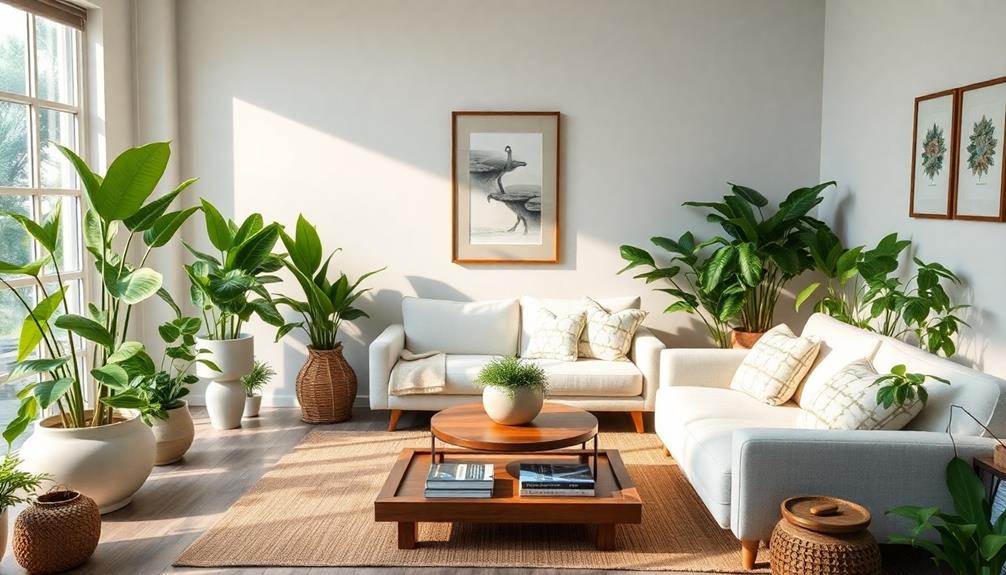
To deepen your understanding of Feng Shui and enhance your home's energy flow, you'll find a wealth of resources at your fingertips. These resources can help you improve the energy in your living space and create a harmonious environment. Here are a few suggestions to get you started:
- Books: Look for titles like *The Complete Illustrated Guide to Feng Shui* by Gavin Atkinson, which offers practical tips and in-depth knowledge.
- Online Platforms: Explore blogs and websites such as Feng Shui for Modern Living, where you'll find insights and case studies on applying Feng Shui principles.
- Community Engagement: Join forums or social media groups focused on Feng Shui. Engaging with fellow enthusiasts allows you to share experiences and solutions.
Additionally, consider attending workshops, webinars, and certification courses to further deepen your knowledge.
The International Feng Shui Guild is a valuable resource that provides articles, workshops, and a directory of certified practitioners to support your learning journey.
With these resources, you'll be well-equipped to transform your home and improve the energy flow effectively.
Frequently Asked Questions
How to Bring Positive Energy Into Your Home Feng Shui?
To bring positive energy into your home, start by decluttering and using the Bagua map. Incorporate the five elements, strategically place furniture, and regularly reassess your space to invite harmony and enhance your well-being.
How to Use Feng Shui in Your Home?
To use Feng Shui in your home, start by applying the Bagua map, decluttering spaces, arranging furniture for a commanding position, incorporating supportive colors, and regularly reassessing your environment to maintain positive energy flow.
What Is the Energy of Feng Shui?
The energy of Feng Shui, or chi, flows through your space, impacting your emotional and physical well-being. It balances Yin and Yang, utilizing the five elements to create a harmonious environment that supports your life.
How to Map Your Home for Feng Shui?
To map your home for Feng Shui, align the Bagua map with your front door. Assess each area's energy, using colors and elements specific to those corners, and adjust it regularly to match your evolving needs.
Conclusion
By embracing Feng Shui, you're not just rearranging your space; you're inviting harmony into your life. When you align your home's energy flow, you open doors to peace, productivity, and prosperity. So, why not take a step today? Transform your surroundings, and watch how your life transforms in return. Remember, a balanced home is a balanced mind—each corner tells a story, and every room holds potential. Let your environment reflect the energy you wish to cultivate.
Home Decor
Feng Shui Secrets Designers Swear By to Create a Calm and Harmonious Home
I uncover essential Feng Shui secrets that designers rely on to cultivate a peaceful home, but there’s so much more to discover for ultimate serenity.
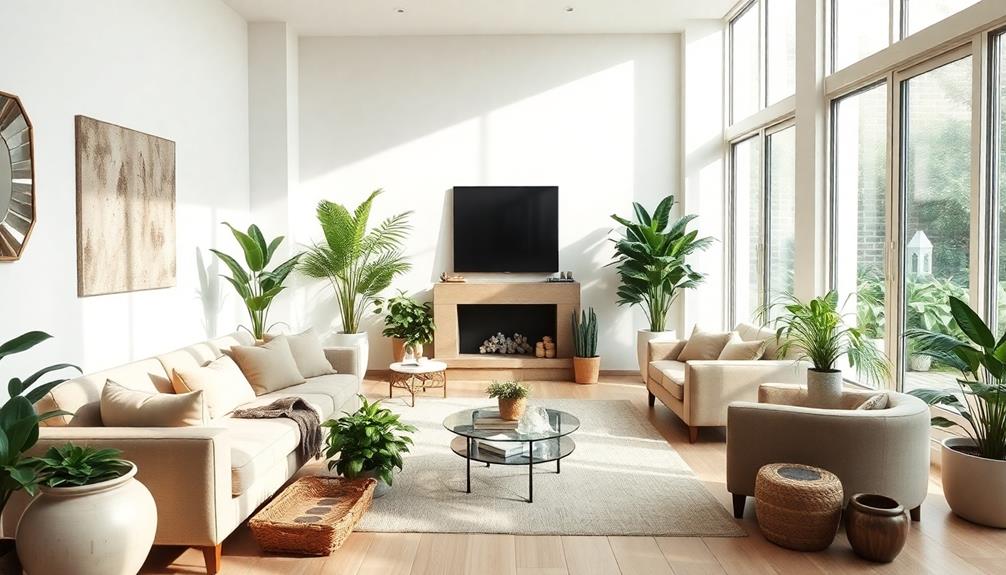
To create a calm and harmonious home, embrace Feng Shui principles that designers swear by. Start by using a Bagua map to identify energy flow in each area. Incorporate the five elements—Wood, Fire, Earth, Metal, Water—into your decor for balance. Prioritize soothing colors like green for family harmony and red for love. Avoid clutter to keep energy flowing freely and position furniture to enhance security and conversation. Use mirrors to amplify light and include natural elements, such as rounded-leaf plants. These strategies lay the foundation for a serene atmosphere, and you'll discover even more effective tips ahead.
Key Takeaways
- Utilize a Bagua map to identify specific areas of your home that correspond to different life aspects for targeted energy enhancement.
- Embrace soothing color palettes, like greens for family harmony and pinks for love, to create a calming environment.
- Position furniture in a command position, allowing for a clear view of the entrance, to promote security and positive energy flow.
- Maintain cleanliness and organization, especially in high-traffic areas, to prevent stagnation and enhance the flow of Chi.
- Introduce natural elements, such as rounded-leaf plants and mirrors, to amplify light and energy while fostering a nurturing atmosphere.
Understanding Feng Shui Principles
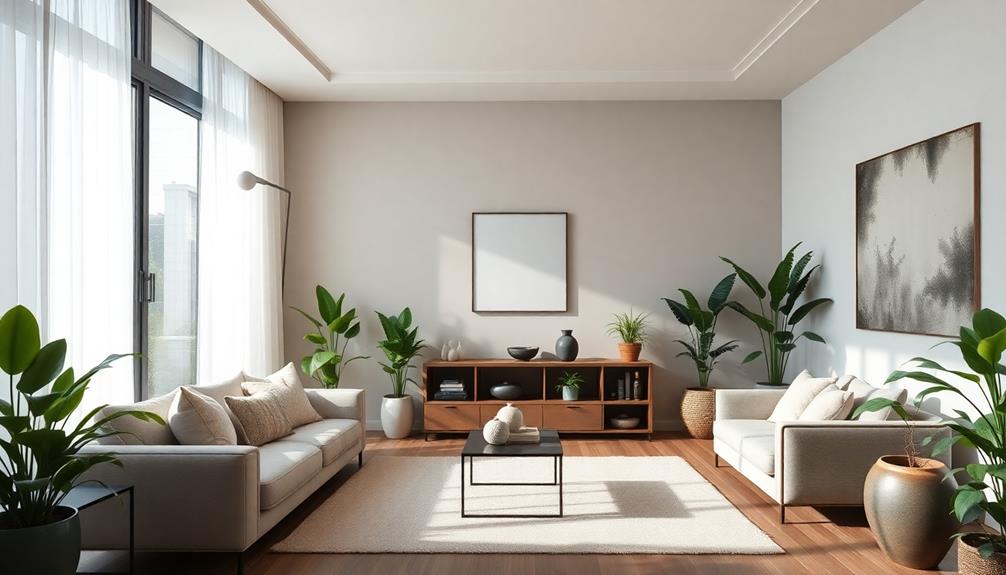
Understanding Feng Shui principles can transform your living space into a sanctuary of peace and balance. This ancient Chinese practice emphasizes the flow of energy, or Chi, in your environment. By making minor adjustments, you can create significant improvements in your quality of life.
Incorporating elements of Balinese design characteristics can enhance the natural flow of energy and create a harmonious atmosphere. The five elements of Feng Shui—Wood, Fire, Earth, Metal, and Water—are vital for achieving balance and harmony in your home. Each element links to specific colors and shapes that enhance positive energy.
Utilizing the Bagua map can guide your design decisions, as it divides your space into nine areas that correspond to different aspects of life, such as career and relationships.
Incorporating Yin and Yang concepts guarantees that opposing forces are harmonized, promoting well-being and tranquility. Proper furniture placement is essential; positioning key items in a commanding position and avoiding sharp corners facilitates a smooth energy flow.
Essential Feng Shui Tools
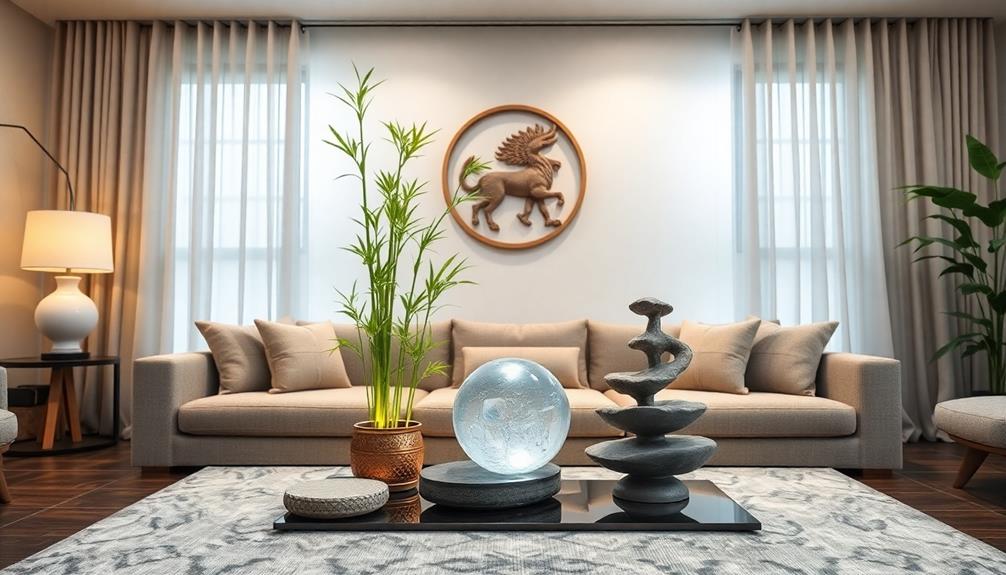
To create a harmonious environment, you'll want to utilize specific Feng Shui tools that enhance the flow of positive energy in your home. One of the most essential tools is the Bagua Map, which divides your space into nine areas, each reflecting different life aspects. Use this map to identify where to focus your energy improvements.
Incorporating Feng Shui Symbols like Buddha statues or wind chimes can greatly enhance positive energy flow and shield against negativity. Additionally, the Five Elements—Wood, Fire, Earth, Metal, and Water—should be included in your decor to balance the elements and support various life aspects.
Additionally, consider the color palette in your interior design ideas. Specific colors promote different energies, such as pink and red for love or green for finances.
Here's a quick reference table for your Feng Shui toolkit:
| Tool | Purpose |
|---|---|
| Bagua Map | Identify focus areas for energy flow |
| Feng Shui Symbols | Enhance positive energy and protection |
| Five Elements | Balance energies in decor |
| Color Palette | Promote desired outcomes |
Key Dos and Don'ts
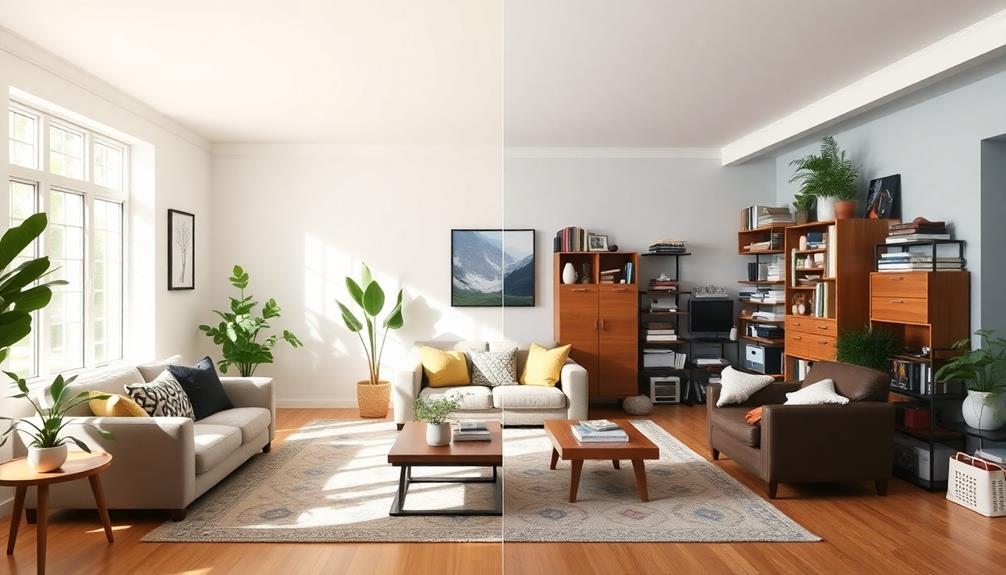
When it comes to creating a calm home with Feng Shui, following key Dos and Don'ts can make all the difference.
First, embrace Feng Shui tips by using soothing colors in your space. Opt for green to enhance family harmony and red to invite love, boosting positive energy throughout your home. Incorporating elements like Indonesian decorative pillows can add vibrant colors and intricate patterns that enhance the ambiance.
On the other hand, don't let clutter accumulate; it obstructs energy flow (Chi) and can lead to feelings of stagnation and stress.
Next, pay attention to furniture placement. Make sure your furniture is in a command position, ideally placed diagonally from the entrance. This setup fosters a sense of security and control.
Conversely, avoid sharp-edged furniture or decor, as they can create negative energy (Sha Qi) and discomfort in your environment.
Room-Specific Guidelines
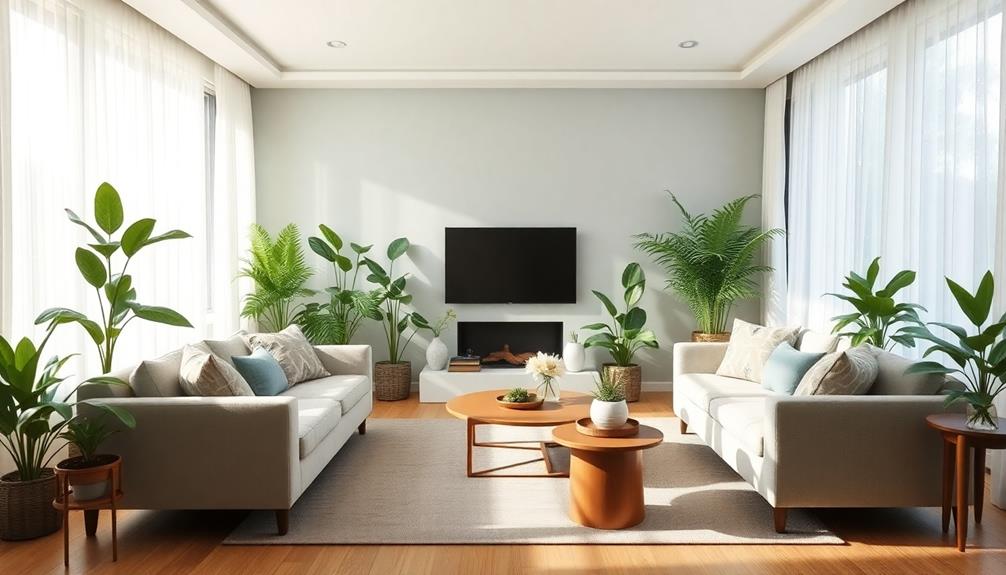
Creating a calm environment goes beyond general principles; it requires attention to each room's unique energy. For example, incorporating elements from luxury tropical designs can enhance the tranquility of your living space.
In your living room, position furniture to promote positive energy flow and encourage conversation. Soft lighting and comfortable seating create a peaceful and calming atmosphere, enhancing social interaction.
For the kitchen, keep the stove and sink clean and clutter-free. Ascertain your fridge is well-stocked and place the stove in a commanding position to optimize energy in your home.
In the bedroom, arrange your bed to have a clear view of the door, using calming colors like soft blues or greens. This creates balance and promotes restful sleep by minimizing distractions from electronics.
Maintain cleanliness in your bathroom, using soft lighting for a serene feel. Keep the toilet lid down and doors closed to preserve privacy and positive energy.
For your home office, position your desk to face the entrance, giving you a sense of control. Ascertain your workspace is organized and filled with natural light to enhance productivity and focus.
Incorporating small touches of color red can also invigorate your space, promoting smooth and uninterrupted energy flow.
Enhancing Energy Flow

Enhancing energy flow in your home is vital for fostering a calm and inviting atmosphere. To achieve this, it's important to create clear pathways, allowing Chi to circulate freely.
Regular decluttering is important; removing unnecessary items prevents stagnation and promotes positive energy to flow throughout your space. Incorporating elements of modern tropical aesthetics in Bali can further enhance this flow, as they emphasize natural materials and open layouts that invite light and air.
Consider the flow of your furniture. Positioning it diagonally from the entrance creates a commanding view, giving you a sense of control and security. This simple adjustment can greatly enhance the overall energy dynamics of your room.
Incorporating mirrors is another effective way to amplify light and energy, especially in darker areas. They not only brighten spaces but also create a visual expansion, making the environment feel more open and harmonious.
Lastly, introduce natural elements like plants with rounded leaves to invigorate your space, promoting a nurturing vibe.
These small changes contribute to creating balance and harmony in your home. By focusing on these strategies, you'll cultivate an environment where energy that flows effortlessly supports your well-being and tranquility.
Frequently Asked Questions
How to Bring Peace at Home Feng Shui?
To bring peace at home, clear clutter to enhance energy flow, position furniture for security, use soothing colors, incorporate warm lighting, and add natural elements like plants to foster a calming atmosphere.
What Is Bad Feng Shui for a House?
Beware of bad feng shui! If your entrance faces a staircase, sharp corners threaten comfort, clutter clogs chi, dark areas dampen mood, and broken items breed stagnation. Tidy up to transform your space!
What Are the Feng Shui Rules for a House?
To create positive energy in your house, follow basic Feng Shui rules. Position your entrance welcomingly, declutter spaces, arrange furniture for comfort and visibility, and incorporate natural elements like plants to enhance harmony and flow.
How to Make a House Lucky Feng Shui?
To make your house lucky, position your entrance for clear views, incorporate the five elements in your decor, keep spaces clutter-free, use mirrors for light, and enhance areas linked to wealth and health.
Conclusion
Just like a well-tended garden thrives, your home flourishes when you embrace Feng Shui principles. By nurturing the energy flow and respecting the essential tools, you transform your space into a tranquil oasis. Remember, a calm home reflects a calm mind, much like a still pond mirrors the sky. So, as you rearrange and refine your surroundings, envision your home as a sanctuary where peace blossoms, inviting harmony into every corner of your life.
Home Decor
The Feng Shui Furniture Rule That Will Instantly Improve Your Space
Get ready to transform your space with the Feng Shui furniture rule that promotes harmony and flow—discover how to elevate your environment today!
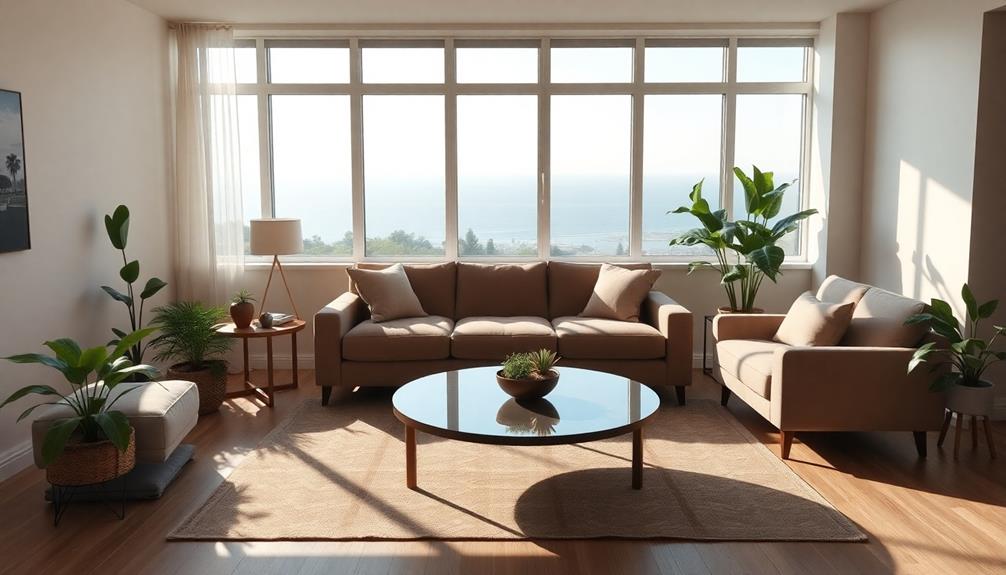
To instantly improve your space, position your furniture in the command position. This means placing key pieces like your bed or desk in a way that you can see the entrance while feeling supported by a solid wall behind you. Avoid pushing furniture against windows or corners to keep energy flowing. Make sure pathways are clear for easy movement. Adding natural elements, like plants, enhances this flow further. With a few tweaks, you can create a harmonious and inviting atmosphere. If you want to explore more ways to elevate your space, there's much more to discover!
Key Takeaways
- Position beds and desks in the command position to enhance energy flow and visibility of entrances for greater comfort and relaxation.
- Clear pathways and avoid clutter to facilitate movement, preventing energy stagnation and promoting tranquility within your space.
- Incorporate natural elements like plants to ground energy and refresh the atmosphere, enhancing vitality in your environment.
- Use soothing colors that resonate with you to influence mood and create a calming ambiance throughout your living space.
- Regularly reassess and update your furniture arrangement to align with personal growth, seasonal changes, and evolving preferences.
Understanding the Command Position

When you understand the command position, you can considerably enhance the flow of energy in your home. The command position refers to the strategic placement of furniture, particularly your bed and desk, allowing you to see the entrance while maintaining distance from direct sightlines. Incorporating elements like Indonesian decorative pillows can further enhance your space with their vibrant colors and intricate patterns, promoting a warm and inviting atmosphere. This setup fosters a sense of security and control, promoting relaxation.
In the bedroom, position your bed against a solid wall, ensuring you have visibility of the door while keeping pathways clear for ideal energy flow. This arrangement not only creates a peaceful sanctuary but also enhances your overall well-being.
In your living room, placing seating in a command position encourages conversation and interaction, enhancing the overall social atmosphere. Similarly, in your home office, position your desk to face the entrance, empowering you to feel aware of your surroundings while you work.
Avoid placing furniture against windows or crammed into corners, as this can disrupt energy flow and create feelings of vulnerability.
Balancing Energy Flow

Mastering the command position sets the foundation for a harmonious living space, but balancing energy flow takes it a step further. To truly enhance your environment, focus on furniture arrangements that create clear pathways and avoid clutter. This allows energy to circulate freely and prevents stagnation.
Consider the following elements to improve your space:
| Element | Importance |
|---|---|
| Clear Pathways | Promote movement and prevent obstruction. |
| Natural Elements | Incorporate plants for grounding energy. |
| Soothing Colors | Use soft tones to enhance tranquility. |
| Visibility of Front Door | Foster comfort and reduce anxiety. |
Position larger furniture pieces to encourage interaction while ensuring visibility of entrances. This not only nurtures a sense of security but also supports social connections. Regularly reassess your furniture arrangement and embrace seasonal decor changes to maintain ideal energy flow. By doing so, you'll create a clutter-free environment that radiates balance and tranquility, transforming your space into a calming sanctuary. Prioritizing these aspects of Feng Shui will elevate your living experience and promote a serene atmosphere for you and your guests. Incorporating feng shui furniture ideas can also inspire creative layouts that maximize both functionality and harmony within your space. Consider using round tables to encourage equality in conversations or placing mirrors strategically to reflect natural light and amplify positive energy. These thoughtful adjustments will further align your home with Feng Shui principles, enhancing its overall warmth and inviting ambiance.
Optimal Furniture Placement
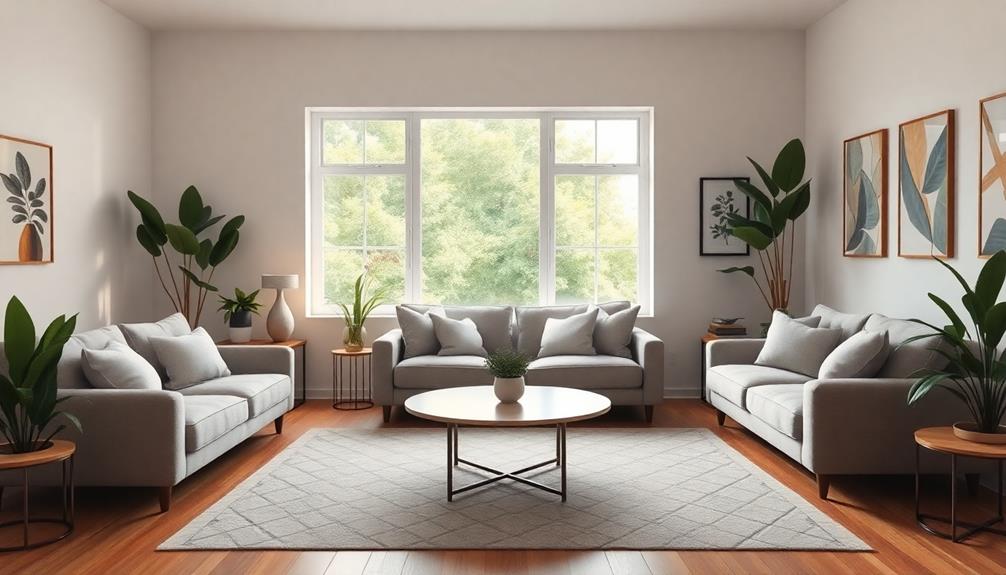
Optimal furniture placement is vital for creating a harmonious living space that promotes positive energy flow. To achieve ideal furniture placement, position larger pieces, like sofas, away from walls. This setup encourages an inviting atmosphere and facilitates conversation while ensuring you can see the front door for a sense of security.
Incorporating elements from Balinese design characteristics can further enhance the energy of your space by blending traditional craftsmanship with modern aesthetics. Avoid placing the back of the sofa against a window, as this blocks energy flow and may lead to feelings of instability.
Arrange seating to promote easy movement and interaction, keeping pathways clear to enhance overall energy. Incorporating natural elements, such as plants, can ground your space and elevate the energy. Place these near natural light sources for ideal growth, as they contribute to a vibrant environment.
Regular reassessments of your furniture arrangement are essential. By making seasonal adjustments, you can refresh your space, ensuring it continues to support your emotional well-being.
Always be open to tweaking your layout; sometimes, a simple shift can greatly enhance positive energy flow and create a more inviting atmosphere. Embrace these strategies to cultivate a space that nurtures both you and your guests.
Personalizing Your Space
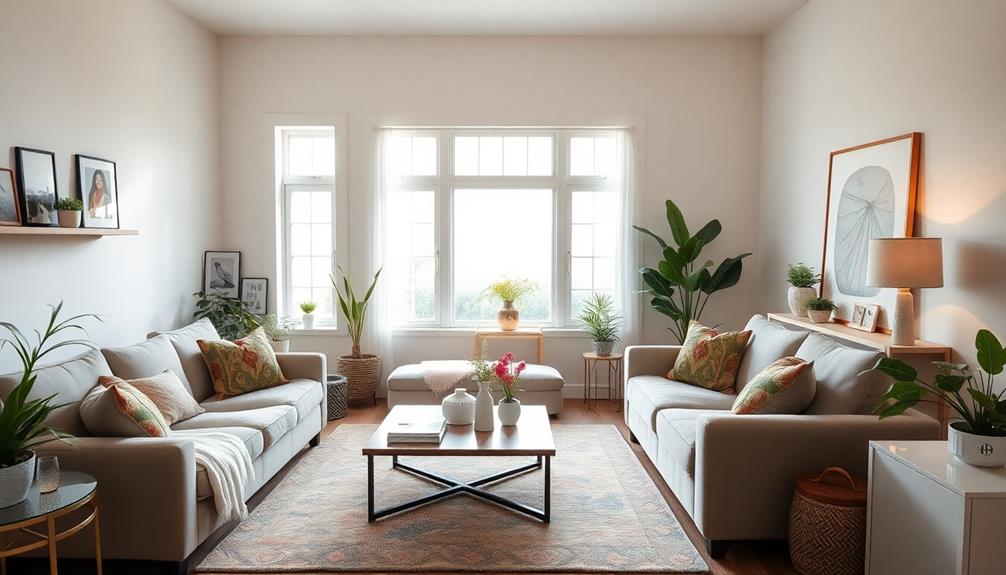
Personalizing your space transforms it into a reflection of who you are, making it feel more like home. Start by incorporating sentimental items like family photos or meaningful artwork, such as a unique Indonesian decor mask that represents rich cultural heritage. These pieces enhance your emotional connection to the space, fostering a sense of belonging.
Choose colors that resonate with you; they can greatly influence your mood and energy levels, promoting a calming atmosphere.
Don't forget to bring in natural elements such as plants and wood materials. These additions ground your space and provide a revitalizing connection to nature.
Regularly reassessing your decor allows you to reflect seasonal changes or personal growth, maintaining ideal energy flow and liveliness in your living area.
Thoughtful placement is key. Grouping objects in odd numbers can create visual appeal and elevate the overall harmony of the room.
Maintaining Harmony Over Time

Maintaining harmony in your space is essential for fostering a positive and inviting atmosphere. To guarantee your environment promotes ideal energy flow, regularly reassess your furniture arrangement. Seasonal changes often call for adjustments, so keep your space feeling fresh and welcoming.
| Action | Purpose |
|---|---|
| Declutter | Prevent stagnant energy |
| Incorporate | Utilize natural elements |
| Personal items | Evoke positive emotions |
| Schedule updates | Keep energy dynamic |
| Refresh energy | Create a calming atmosphere |
By decluttering consistently, you'll prevent stagnant energy, allowing tranquility to flourish. Incorporating natural elements like plants can further refresh energy, creating a calming atmosphere that nurtures your well-being. Don't forget to include personal items that evoke positive emotions, enhancing the overall harmony of your space.
Lastly, schedule periodic updates to your decor and furniture placement. This keeps your living space aligned with your evolving preferences and lifestyle. Embrace these practices to maintain harmony over time, guaranteeing your home remains a sanctuary that supports your journey to well-being.
Frequently Asked Questions
How to Feng Shui Your Space?
To feng shui your space, arrange furniture for clear pathways, promote conversation with seating, incorporate natural elements, use calming colors, declutter regularly, and strategically place mirrors to enhance light and energy flow.
How to Place Furniture According to Feng Shui?
Placing furniture's like arranging a dance; you want partners to face each other. Position your seating to encourage conversation, clear pathways for movement, and always guarantee a view of the door for security and comfort.
How Can I Improve My Room Feng Shui?
To improve your room's feng shui, position your bed for visibility of the door, declutter pathways, use soothing colors, add plants, and regularly reassess your arrangement for ideal energy flow and tranquility.
How Do You Arrange Furniture for Positive Energy?
To arrange furniture for positive energy, create clear pathways, position seating to face the door, encourage conversation with your layout, and incorporate natural elements. Regularly refresh arrangements to maintain an uplifting atmosphere in your space.
Conclusion
By following these feng shui principles, you can transform your space into a sanctuary that feels both inviting and balanced. Remember, it's all about creating harmony and flow. Have you considered how your furniture placement affects your daily energy? With a little mindfulness and personalization, you'll not only enhance your surroundings but also elevate your mood. Keep reassessing and adjusting as needed to maintain that perfect balance and guarantee your space continues to inspire you.
-

 Mom5 months ago
Mom5 months agoHeartfelt Poems for Your Daughter’s Birthday
-

 Mom5 months ago
Mom5 months agoHappy Birthday Religious Wishes and Blessings
-

 Mom5 months ago
Mom5 months agoHappy 65th Birthday: Celebrate Your Special Day!
-

 Mom5 months ago
Mom5 months agoHappy Birthday in Heaven from Daughter: Remembering You
-

 Mom5 months ago
Mom5 months ago62nd Birthday Quotes for Mom: Celebrate Her Special Day
-

 Mom5 months ago
Mom5 months agoCelebrating 60 Years: Happy 60th Birthday Wishes
-

 Special Occasions4 months ago
Special Occasions4 months agoUplifting Words: Inspirational Church Anniversary Messages!
-

 Mom5 months ago
Mom5 months agoCelebrate a Joyous Happy 70th Birthday Milestone!

















